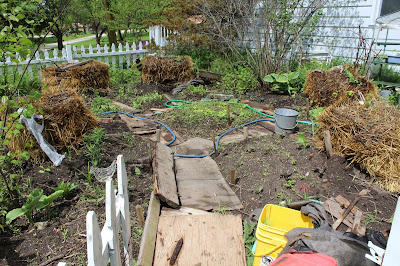“Success consists of going from failure to failure without loss of enthusiasm.” - Winston Churchill
 |
I like trying new things. They don't always work. Sometimes they are a complete failure, other times I just lose interest. But once in a while they're a success!
The straw bales, I have to say, I am counting as a huge success. It may have been an alignment of the stars and by stars I mean a combination of favorable weather conditions. We've had pretty good weather, not too hot or dry. I think the Japanese beetles came out later than usual this summer. The mosquitoes haven't been too bad which doesn't have much effect on plants but has a great effect on me and my interest in the vegetable garden. Finally, and most importantly and the only factor which I had any control of was my whole design plan and new outlook on the vegetable garden.
So, the groundwork was laid and the conditions were right. I conditioned and planted the bales. I read all the instructions on the internet. The success or failure of the straw bales determined whether I would have garden ripe tomatoes, basil, peppers and so on.
I was practical, yet hopeful. I put in the small bargain plants so as not to lose too much money on the experiment. I took advantage of the warm composted bales and planted extra early in case I needed to start over the traditional way.
It's late July and the bales have composted and sunken down onto the organic material I laid underneath them. They soak up much more water now than in the beginning. I have no worries about soil born tomato diseases since everything grows a few feet up off the ground. This also helps with air circulation so powdery mildew has not been a problem.

That said, I have a few tips and pointers that I learned from the experience.

1. Get your bales early in Spring or even the Fall before if possible. Let them go through the stages of composting including a period when the mushrooms started coming up all over the place.

2. If you're tying 2 bales together, which I recommend for the larger planting area, tie them tightly with multiple layers of twine. Nylon string would be even better because it won't decay and break as it's exposed to water and sun.

3. If you're planting seeds directly into the bales separate the straw a little bit and sprinkle in a little potting soil in so the seeds have something to start in and so they don't fall too far into the bale.

4. If the bales do break open you can try to retie or just hold them together with posts or sticks stuck into the ground, close to the side of the bale.
 5. Tomato cages and stakes can be stuck right into the bales for stability.
5. Tomato cages and stakes can be stuck right into the bales for stability.

6. Apply a fertilizer high in nitrogen midway through the summer or when the plant leaves begin to loose their dark green color.
“Success is not final, failure is not fatal: it is the courage to continue that counts.” - WC
Keep it fresh! Have fun!















No comments:
Post a Comment